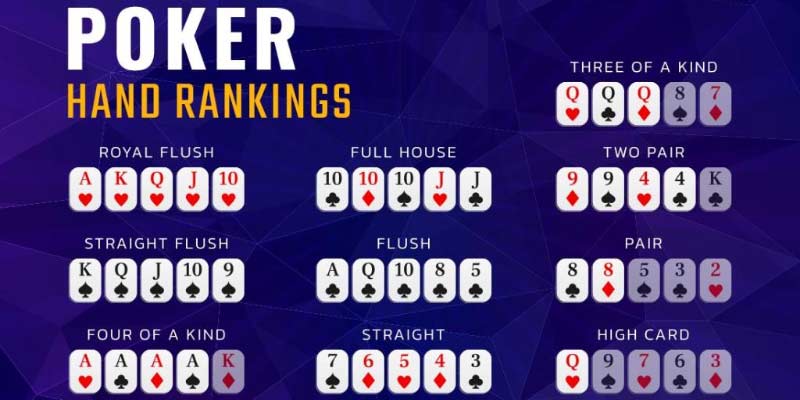
Poker Hand Rankings: The Ultimate Guide
Understanding poker hand rankings is crucial for any player looking to succeed in the world of poker. Whether you’re a beginner or a seasoned player, knowing these rankings can give you a significant edge at the tables. In this guide, we will delve deep into the different types of poker hands, their hierarchy, and how to effectively use this knowledge in your poker strategy 789bet.
Understanding Poker Hand Rankings
Before plunging into the details, it’s essential to grasp what poker hand rankings entail. Poker hand rankings are the set rules that determine the strength of various combinations of cards in poker. Every variation of poker abides by these rankings to decide which player wins a round.
Poker involves a mix of skill, psychology, and luck, but understanding the hand rankings is the foundational element upon which everything else builds. Players who know poker hand rankings inside out can make more informed decisions about betting, bluffing, and calling opponents’ bets.
The Role of Poker Hand Rankings in Game Strategy
Incorporating poker hand rankings into your strategy is vital. Knowing which hands are stronger than others helps you evaluate your position during play, deciding when to bet aggressively or fold meekly.
Additionally, players can also read their opponents better by observing betting patterns based on perceived hand strengths. A solid grasp of poker hand rankings can help identify likely winning hands and provide insights into how aggressive or passive the gameplay should be.
How to Memorize Poker Hand Rankings
Memorizing poker hand rankings can be daunting for newcomers. However, there are techniques that can make it easier. One popular method is the “High Card to Royal Flush” mnemonic, where each hand’s name correlates with its rank.
Visual aids like charts and flashcards can also significantly enhance retention. Playing regularly helps reinforce the rankings through practice, allowing players to intuitively recall them during games.
The Ultimate Guide to Poker Hand Rankings
Poker hand rankings aren’t just an arbitrary list; they serve as the backbone of poker strategy and decision-making. This section will provide a comprehensive overview of the most common hand rankings and their significance.
The Basics of Poker Hand Rankings
At its core, poker consists of several ranking categories, each depicting the strength of card combinations. Here’s a brief introduction to the main ranks:
- High Card – The weakest hand type, determined by the highest single card.
- One Pair – Two cards of the same rank, supported by three other cards.
- Two Pair – Two distinct pairs, plus one additional card.
- Three of a Kind – Three cards of the same rank.
- Straight – Five consecutive cards, regardless of suit.
- Flush – Any five cards of the same suit, not in sequence.
- Full House – A combination of three of a kind and a pair.
- Four of a Kind – Four cards of the same rank.
- Straight Flush – Five consecutive cards of the same suit.
- Royal Flush – The highest possible hand, consisting of 10, Jack, Queen, King, and Ace of the same suit.
Evaluating Hand Strengths
Understanding the strength of hands allows players to make educated guesses about their likelihood of winning. High Card hands might win occasionally but typically lose against any other ranked hand, while Stronger hands like Full Houses or Four of a Kinds consistently dominate gameplay.
Evaluating hand strengths can also involve calculating odds and percentages. For instance, if a player believes they’re holding a strong hand, assessing potential draw scenarios—what could happen if future community cards enhance their hand—is crucial.
The Importance of Position in Poker
Your position at the table can impact how you interpret poker hand rankings. Being ‘in position’ means acting after your opponents, offering valuable insights into their actions and allowed leverage for strategic betting.
For example, if you are in late position and see a strong hand played aggressively by early players, you might choose to bluff or fold rather than risk your chip stack. Thus, understanding your own hand’s strength based on position can dramatically influence game outcomes https://789bet.domains/.
Exploring the Hierarchy of Poker Hands
The hierarchy of poker hands is fundamental in determining which hand wins during a showdown. Each type is ranked against others, creating a clear competitive landscape.
The Fundamentals of Poker Hand Hierarchy
The hierarchy follows a strict order from strongest to weakest, which is universally recognized across most poker variations. Understanding this order is essential for quick decision-making during gameplay.
Each hand builds upon the previous rank, meaning that as you move down the list, the likelihood of beating higher-ranked hands decreases dramatically. This hierarchy fosters not only gameplay strategy but also psychological tactics as players attempt to gauge their opponents’ hands.
Situational Awareness During Gameplay
While the hierarchy provides a foundation, situational awareness is critical. Recognizing when to push an advantage or retreat requires understanding the board and opponent tendencies. If you’re holding an excellent hand but face unexpected aggression, it’s wise to consider your opponent’s potential holdings rather than strictly adhering to the rankings.
Moreover, poker is a dynamic game that evolves with every hand played. Adapting to the changing circumstances enables players to maintain a strategic advantage over time.
Advanced Ranking Insights: Understanding Kickers
Kickers are the unique cards in poker hand rankings that come into play when two players have matching hands. They can often mean the difference between winning and losing.
For instance, if two players hold a pair of Kings, the player with the highest additional card becomes the winner. Understanding kickers improves accuracy when gauging the strength of your hand and can also affect bluffing strategies depending on the context of the game.


